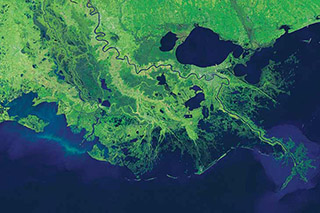The lower Mississippi delta. Source: NASA Earth ObservatoryAmid all the rhetoric about climate and sea level rise and the rest of it, a long-term opportunity for the workboat industry is clearly emerging.
Environmental planners and engineers call it “resilience” – remaking coastal cities and industries to withstand the slow creep of sea level, especially on the Gulf of Mexico and mid-Atlantic coasts, and escape the catastrophic costs of hurricanes like Katrina in 2005 and Sandy in 2012.
It is about flood protection, an old and familiar struggle for people on the Gulf Coast, but one that came as a surprise for many in the Northeast when Sandy pushed a 13’ surge up New York Harbor, water levels not seen since a great hurricane in 1821.
But it is also a movement toward making cities more livable, reclaiming the waterfront both for commerce and civic life. By no accident are experts from the Netherlands in the thick of this, coming from the land where for hundreds of years people have stood at eye level with the sea and built a thriving society.
Such was the shock from Sandy that the U.S. Department of Housing and Urban Development put out $920 million for its “Rebuild By Design” projects in New York and New Jersey, soliciting proposals to rebuild the harbor cities’ drainage systems and waterfronts. There will be big projects like hurricane barriers and floodgates, but also “soft” systems, like public parks and playing fields that do double duty capturing flood waters, and in the harbor, oyster reefs and wetlands built higher with dredge sediment.
That’s small change compared to Louisiana, where coastal restoration to preserve the Port of New Orleans and the base for 30 percent of America’s energy resources might cost between $50 billion and $100 billion. There is no assurance all that money will be coming, as John M. Barry, a critic of the state’s energy industry and ousted member of the Southeast Louisiana Flood Protection Authority East, has often said.
But clearly something is going to – has got to – happen, and soon. Some money, maybe not enough for now, is coming together to rebuild the Gulf Coast, and dredgers and waterway operators will play a huge part.
In time, energy industries could help finance the restoration, swapping wetlands restoration as carbon credits for emissions.
Some of the ideas – like relocating the Mississippi’s Bird Foot delta many miles west – may sound crazy now.
But then, 140 years ago some people thought Capt. James Eads was nuts, before he delivered on his promise to stake the river’s outlet in place and deepen it with his jetties. That skyrocketed exports from the Port of New Orleans to Europe by a factor of 70 within five years, enabling the city’s greatness.





